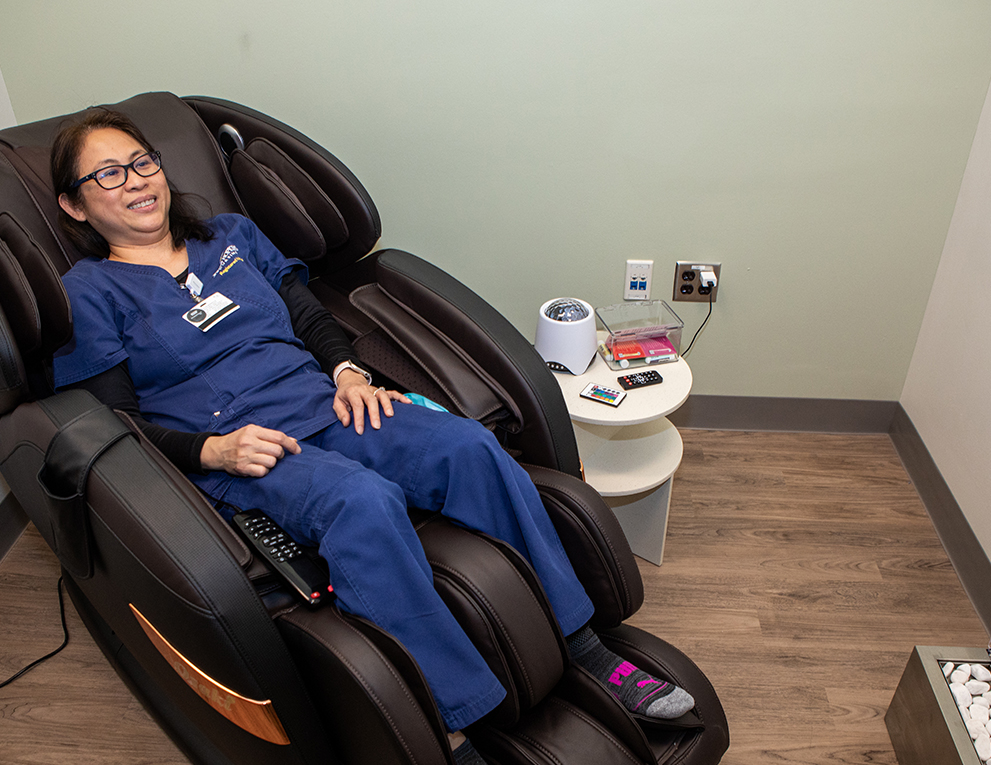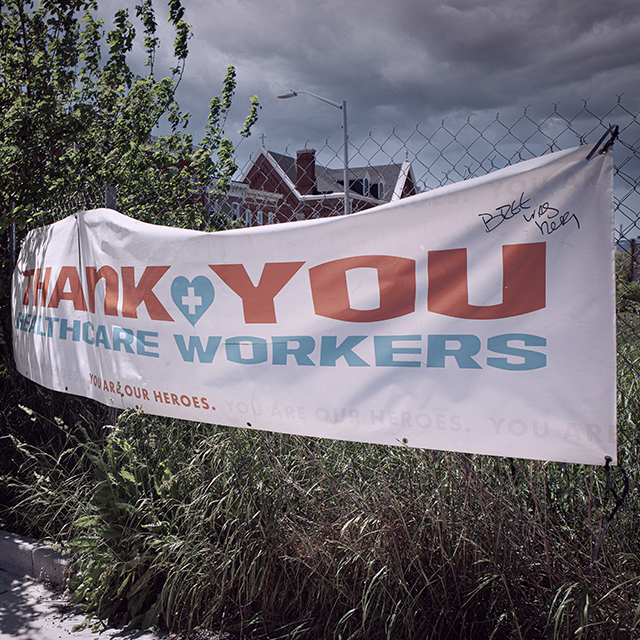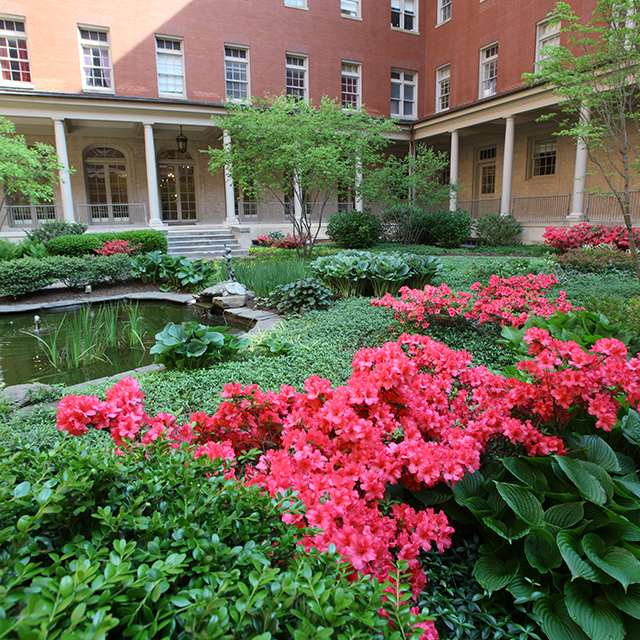A Place to Relax
The new RISE Restorative Space gives employees a place to unwind.

Nurse Educator Melanie Mallari, M.S.N., relaxes in the sensory room. Photo by Marc Shapiro
As a RISE (Resilience in Stressful Events) responder, Jane Miller will never forget the time a physician phoned her from a closet.
“There was nowhere else to go,” says Miller, the RISE program administrator for the Johns Hopkins Health System. “The doctor didn’t want anyone to find them. In such states of distress, employees need privacy and support.”
Responding to incidents like that one, the RISE team recognized the need for employees to have a space to comfortably unwind and decompress.
The RISE Restorative Space, on Osler 6 at The Johns Hopkins Hospital (JHH), opened earlier this year to offer the kind of respite employees so often need. The space includes rooms for relaxing alone, group gatherings and peer support.
“The life-saving work we do here at The Johns Hopkins Hospital is vitally important, but it is also intense and fast paced and incredibly demanding,” says Redonda Miller, M.D., M.B.A., president of the hospital. “We are thrilled to be able to offer our dedicated employees these calm and relaxing spaces, where they can shut the world out for 15 minutes or a half-hour and just take the time they need for themselves.”
Operated by the RISE team with support from the Office of Well-Being, the space was designed using neuroaesthetic principles based on research from the International Arts + Mind Lab (IAM Lab) at the Pedersen Brain Science Institute.
The sensory room features a massage chair, bubble lights that change color, aromatherapy, a light projector and Bluetooth-connected speakers.
Nurse educator Melanie Mallari, M.S.N., has used it several times.
“It’s a sanctuary you can retreat to,” she says. “I really appreciate the feeling of your muscle tension being released. You feel it immediately when you get up from the chair.”
The room accommodates one person at a time and requires registration. Sign up here.
Another room features a bed donated by a New York-based company that vibrates in sync with neural music to reduce stress. One person at a time can use the room, and registration is required. Sign up here.
“Having spaces like this enables people to take a moment to check in with how they are feeling, to relax, slow down and recalibrate, and to connect to support resources.”
Suzanne Brockman, senior program administrator with Office of Well-Being
In the private consult room, employees take part in confidential sessions with the RISE team. The Johns Hopkins Employee Assistance Program, which provides counseling and referral services for employees and their family members, is on-site for in-person sessions on Tuesdays.
The fourth room, which doesn’t require registration and is open 24/7, is a group gathering and art therapy space. The group gathering area can be reserved for up to eight people by sending an email to [email protected].
Jasmine Myers, an administrative coordinator on Meyer 2 at JHH, brought a co-worker to the Restorative Space on a recent afternoon. She particularly liked the sensory room, and she plans to use it regularly.
“Even if it’s a five–10 minute getaway, it’s definitely needed for your mental state, just to calm yourself down, relax a little bit and relax muscles you may not even know are tensed up,” Myers says. “It’s something every hospital should have.”
Lee Biddison, M.D., M.P.H., chief wellness officer at Johns Hopkins, echoes Myers’ sentiments.
“We recognized that it was important, not just during the pandemic but on an ongoing basis, for people to be able to take a break in the midst of their workday to decompress in a place where they feel comfortable and safe — really just taking a step back from the intensity of their work, because what we do is stressful,” Biddison says.
Susan Magsamen, M.A.S., executive director of the IAM Lab Center for Applied Neuroaesthetics, says expressive art interventions have been shown to lessen burnout and stress. The IAM Lab collaborated with the RISE program to develop pre-surveys and post-surveys to gauge user experience and understand the impact of the Restorative Space on employees’ well-being. The center incorporates biophilic designs, which integrate natural themes and elements.
“At the RISE Center, this concept is embodied through the incorporation of biophilic furniture, greenery, lighting and color schemes,” Magsamen says.
The IAM Lab partnered with a Scandinavian design company that donated furniture and biophilic furniture and furnishings.
Cheryl Connors, D.N.P., M.S., RISE program director, was instrumental in this initiative. She says the RISE team learned that social connection is the greatest predictor of resilience.
“We wanted a space where people could connect,” she says. “We’ve also learned that peer support isn’t for everybody, and what the space offers is a variety of modalities for people to recharge, restore, refresh and relax in whatever way they choose.”
How to Get There
Take the Nelson elevators to level 6, turn right and go through the double doors at the end of the hallway. You will need to swipe your Johns Hopkins ID to enter the hallway and again to enter rooms.
View locations of Johns Hopkins Medicine Recharge locations at other facilities here.
Related Reading
-
One Year Later: Are Front-Line Workers Still ‘Heroes’?
After 15 months of battling the COVID-19 pandemic, front.-line workers discuss the phrase 'health care heroes' — and if they ever felt like heroes — as they continue to care for sick patients.

-
Cultivating a Landscape of Well-Being at The Johns Hopkins Hospital
Members of the grounds crew at Johns Hopkins’ East Baltimore campus work an ever-changing landscape designed to lift the spirits of employees, patients and family members entering the hospital.

